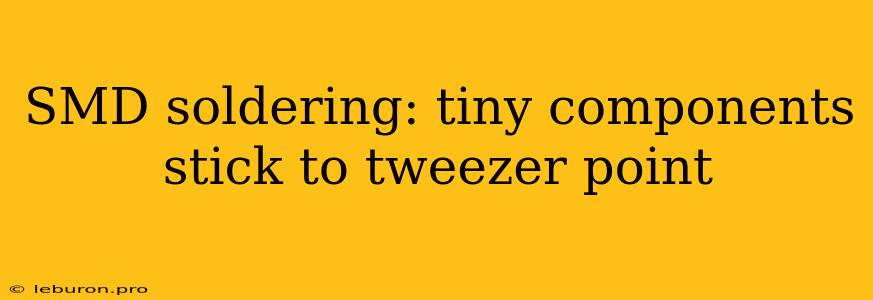Soldering surface-mount devices (SMDs) can be a delicate task, especially when dealing with the tiniest components. The challenge often lies in manipulating these minuscule parts without damaging them. One common issue is the tendency for SMDs to stick to tweezers, making placement and soldering a frustrating endeavor. This phenomenon, often referred to as "SMD sticking," is a result of static electricity, surface tension, and the adhesive nature of flux residues. This article explores the root causes of SMD sticking and offers practical solutions to prevent this troublesome issue.
Understanding the Causes of SMD Sticking
Static Electricity: Static electricity plays a significant role in attracting SMDs to tweezers. As you handle components, friction can generate static charges on both the tweezers and the SMDs. These opposing charges create an electrostatic force that draws the components towards the tweezers.
Surface Tension: The tiny solder pads on SMDs can have a high surface tension, especially when coated with flux. This tension acts like a thin adhesive layer, causing the SMD to stick to the tweezers due to the intimate contact.
Flux Residues: Flux, a chemical paste applied during soldering, serves to clean the metal surfaces and facilitate solder flow. However, residue from the flux can remain on the SMDs, creating a sticky layer that contributes to adhesion.
Preventing SMD Sticking: A Practical Guide
1. Grounding: The first line of defense against static electricity is proper grounding. Use a grounding wrist strap connected to a grounded workbench to dissipate static charges from your body.
2. Anti-Static Tweezers: Anti-static tweezers are essential for handling SMDs. These tweezers are coated with a conductive material that helps neutralize static charges.
3. Clean Tweezers Regularly: Regular cleaning of tweezers is crucial to prevent flux residues and other contaminants from building up. Isopropyl alcohol or a specialized cleaning solution can be used for effective cleaning.
4. Avoid Excessive Force: Gentle handling is key. Excessive force can distort the SMD and increase the risk of sticking.
5. Controlled Placement: Practice controlled placement techniques. Gently touch the SMD to the pad and let it settle, rather than forcing it down.
6. Use a Soldering Iron with Fine Tip: A soldering iron with a fine tip allows for precise heat application, minimizing heat damage to the SMDs.
7. Apply Heat Evenly: Apply heat evenly to the pads to melt the solder and allow the SMD to adhere properly.
8. Minimize Flux Usage: Use a minimal amount of flux, only enough to facilitate soldering. Excess flux can lead to residue build-up.
9. Clean Flux Residues: After soldering, remove any excess flux residue with isopropyl alcohol or a flux remover.
10. Utilize Soldering Aids: Tools like vacuum tweezers, tweezers with pointed tips, and tweezers with serrated jaws can aid in picking up and placing SMDs, reducing the risk of sticking.
11. Solder Paste and Stencil: For higher-volume SMD soldering, solder paste and a stencil are highly effective in placing the components precisely and minimizing flux residue.
Conclusion
SMD sticking can be a common frustration for hobbyists and professionals alike. By understanding the underlying causes and implementing the recommended preventative measures, soldering tiny components can be a less stressful and more efficient process. From proper grounding and anti-static tweezers to controlled placement techniques and clean soldering practices, these solutions can drastically reduce the incidence of SMD sticking, ensuring smooth and successful soldering projects. Remember, the key to avoiding SMD sticking is a combination of careful handling, meticulous cleaning, and the appropriate tools and techniques.
